Abstract
This study investigates the composition and spatial distribution of benthic foraminiferal assemblages in the estuaries of the Mamanguape and Paraíba rivers in Northeast Brazil. Samples were collected from different sectors along both estuaries and analyzed for foraminiferal density, diversity, and species composition in relation to abiotic factors like salinity, temperature, pH, and sediment grain size. Results show that calcareous foraminifera dominate both estuaries, likely influenced by stable pH and salinity gradients. Additionally, the sediment composition of both estuaries varies from typical tropical estuarine patterns, with the presence of coarse and medium sands suggesting significant environmental dynamics. Statistical analyses confirm that foraminiferal assemblages reflect spatial environmental variations within and between the estuaries, underscoring the potential of foraminifera as bioindicators in coastal ecosystem assessments.
1. Introduction
Benthic foraminifera (kingdom Chromista, phylum Foraminifera) are single-celled organisms that are abundant in all marine environments, from deep-sea settings to transitional areas [1,2,3,4]. There are currently approximately 48,000 cataloged species, both fossil and recent, making them the most diverse group of shelled microorganisms in modern seas [5]. They typically have a short life cycle and are considered environmental sentinels, with their tests preserved in sedimentary records after death [6,7,8]. Globally, foraminifera play significant functional roles in the benthic environment, contributing to bioturbation, seabed ventilation, nutrient cycling, and the global geochemical cycles of carbon and nitrogen [9,10,11,12,13,14,15,16].
Like other benthic organisms, the structure of foraminiferal assemblages is influenced by abiotic and biotic factors. Consequently, the abundance, diversity, and composition of these assemblages are jointly controlled by the physical and chemical parameters of the environment [2,3,17]. Some of these parameters include temperature, salinity, food distribution and availability, energy state at the benthic/pelagic boundary, oxygen availability, substrate type, and bottom morphology [3,18,19,20,21,22]. Additionally, foraminifera possess characteristics that make them ideal for assessing environmental health, such as a short lifespan and the high preservation potential of their tests in sedimentary records [8]. As a result, these assemblages are sensitive to environmental changes, whether natural or anthropogenic [3,7,23,24,25,26]. Since variations in environmental parameters create specific habitats for different species, making some microhabitats suitable for some species but uninhabitable for others, benthic foraminiferal associations can be used as indirect indicators of changes in environmental parameters [27,28,29].
Estuaries are transitional environments located at the interface between continental and marine waters [30]. Due to exposure to variable physico-chemical parameters and strong environmental gradients, estuaries are naturally stressed by daily exposure to various environmental factors such as ocean currents, hydrology, rainfall, temperature, and dissolved oxygen [31,32,33]. Furthermore, about 70% of the world’s population lives in coastal regions, resulting in significant ecological stress on aquatic systems, particularly estuaries [33,34].
Thus, there is a need for methods to monitor these environments. Strategies can be adopted to characterize, assess, and monitor environmental quality [35]. For approximately 20 years, benthic organisms have been used as bioindicators of environmental quality [36]. The study of foraminiferal assemblages can provide valuable information about marine ecosystems [37]. The use of these organisms as indicators of environmental quality in coastal areas has been increasing [2,38,39,40,41,42,43].
Therefore, studies on the composition, abundance, and distribution of foraminiferal assemblages in different environments are essential. This study aims to analyze the composition and spatial distribution of benthic foraminifera in the estuaries of the Paraíba and Mamanguape rivers (7° S, Brazil) and relate their distribution to abiotic parameters, recognizing variations in benthic foraminiferal distribution along the salinity gradient and grain size.
2. Materials and Methods
2.1. Study Area
The estuaries of the Mamanguape and Paraíba rivers belong to the Northeast Brazil Marine Ecoregion [44]. According to the Köppen–Geiger climate classification, the climate in both estuaries is of type As, meaning equatorial with a dry summer [45]. The rainy season extends from February to August, with the highest rainfall occurring in June and the lowest in November [46]. The Paraíba River estuary has a wetter climate (with an average annual precipitation of 1717 mm) than the Mamanguape River estuary (with an average annual precipitation of 1392 mm) [47]. The tides are semi-diurnal, with a maximum level of 2.2 m in the Mamanguape River estuary and 2.8 m in the Paraíba River estuary [48,49].
The Paraíba River estuary covers an area of 20,124 km2, draining the cities of João Pessoa, Bayeux, and Santa Rita, and near its mouth, the port city of Cabedelo [48,50] (Figure 1A). The region of the Paraíba River estuary houses the Cabedelo Restinga National Forest designated as a Priority Area for Biodiversity Conservation across nine categories, including ecosystems (estuary, restinga, wetlands, and reefs) and zoological groups (elasmobranchs, birds, fish, benthos, and mammals) [51]. Despite this, the estuary lacks a protected area; it suffers from numerous anthropogenic impacts such as domestic and industrial sewage discharge, port activities, sugarcane cultivation, shrimp farming, boating activities, recreation, and tourism [46,52,53].
The Mamanguape River estuary covers an area of 3522 km2 and includes an Environmental Protection Area aimed at protecting coastal ecosystems and the population of marine manatees (Trichechus manatus) in the region [50,54] (Figure 1B). There is a well-preserved mangrove forest in the area, which grows around the primary channel and extends over 600 hectares, along with remnants of the Atlantic Forest [55]. However, extensive sugarcane fields and aquaculture areas for shrimp production are found beyond the mangrove area [46]. The river mouth forms a 6 km wide bay that is almost closed by a coastal reef line, resulting in calm waters [46].
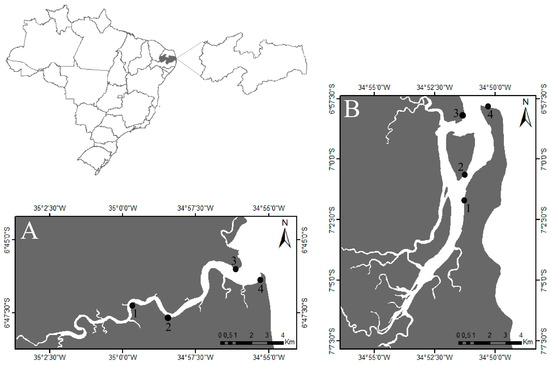
Figure 1.
Map of part of the coast of Paraíba showing the two estuaries studied: (A) Mamanguape River estuary and (B) Paraíba River estuary. The circles on the map indicate the points where the samples were collected. Generated in the ocean data view program [56].
2.2. Sampling
Samples were collected on 8 and 10 February 2020, respectively from the Mamanguape and Paraíba river estuaries. Samples were taken randomly from the external, intermediate, and internal sectors, distributed from the mouth to the inner part of the estuary, on the exposed shoreline at low tide (Figure 1). Three replicates were collected at each point. Sampling was conducted using a 15 cm diameter PVC pipe inserted 10 cm into the sediment. For each replicate, 50 mL of surface sediment (top 2 cm) was collected with a spoon. The collected material was fixed in a 70% alcohol solution containing Bengal rose dye (1 g/L) to stain the protoplasm of living specimens. At the time of collection, salinity, dissolved oxygen, temperature, total dissolved solids, and pH were measured using a multiparameter probe (Series U-50-Horiba). Salinity was measured by conductivity and therefore has no unity [57]. Additionally, sediment was collected and kept frozen for grain size analysis.
2.3. Laboratory Procedures
In the laboratory, samples were washed with running water on sieves with mesh sizes of 63 μm and 125 μm. Then, the sediment retained on each sieve was transferred to filter paper and dried in an oven at 50 °C for 48 h. The samples were then examined under a stereomicroscope, and 300 specimens were picked (150 from each size fraction totaling 300 specimens from each replicate) using a fine-tipped brush and placed in a dark plate. Identification was carried out according to Boltovskoy et al. [58], Laut et al. [59,60], Lei & Li [61], Symphonia & Senthil [62], and Damasio et al. [63], with nomenclature standardized according to the online platform WoRMS-World Register of Marine Species [5].
After washing and sorting the 300 benthic foraminifera from each replicate, density calculations were performed. Samples were fractionated between 1/4 and 1/64 so that small fractions of each replicate could be analyzed. After counting all individuals (alive and dead, the living ones will be pink-colored) in the fraction, the value was multiplied by the denominator to estimate the sample density. The granulometric study was conducted according to Suguio [64] at the Meiofauna Laboratory (Federal University of Campina Grande), by sieving dry sediments (100 g) from each station using a sieve shaker with intermittent tapping (ROTAP). Afterward, each mesh was weighed again to determine the percentage of each grain size fraction present in the samples.
2.4. Data Analysis
The Shannon–Wiener diversity index (H’) [65] was applied to calculate diversity, while Pielou’s index [66] was used for equitability. A two-way analysis of variance (ANOVA) was performed to compare species number, diversity, and equitability according to estuary and sampling point.
To test whether community structure differed among the factors “Estuary” and “Sampling point” and their interactions, a permutational analysis of variance (PERMANOVA) was conducted. Species abundance data in each replicate were log-transformed (log (x + 1)), and a similarity matrix was generated using Bray–Curtis similarity. The analysis was performed using residual permutation under a reduced model, with p-values calculated from 999 random permutations. Factors used were estuary (Mamanguape and Paraíba) and sampling points (1, 2, 3, and 4) [67]. Additionally, a percentage similarity analysis (SIMPER) was performed to identify the species contributing to the similarity between tested groups [68]. Species abundance data from each replicate were log-transformed (log (x + 1)), and a biological data similarity matrix was constructed using Bray–Curtis, while the Euclidean distance was used for the abiotic data similarity matrix.
In order to relate the foraminifera species that contributed > 1% of the total abundance to the environmental parameters considered (temperature, salinity, dissolved solids, dissolved oxygen, pH, and grain size), we used redundancy analysis (RDA). The longest gradient length for detrended correspondence analysis (DCA) was 2.004, supporting the choice of RDA for the community analysis [69]. DCA was performed using the abiotic and relative species abundance data were log-transformed (log (x + 1)).
Diversity, equitability, PERMANOVA, and SIMPER analyses were carried out using Primer v6 [70] with the PERMANOVA+ expansion [71]. ANOVA was performed using STATISTICA 8 software [72], DCA and RDA were performed using CANOCO for Windows 4.5 [69].
3. Results
The temperature in the Mamanguape River estuary relatively constant, ranging from 30.7 °C to 31.3 °C (Figure 2), while in the Paraíba River estuary, it varied between 30.7 °C and 34.43 °C (Figure 2). Salinity ranged from 26 to 36.6 in the Mamanguape estuary and from 31.4 to 36.6 in the Paraíba estuary, with the highest values observed in the external sectors (Figure 2). Dissolved oxygen varied from 5.2 to 9.6 mg/L in the Mamanguape estuary and from 3.35 to 7.52 mg/L in the Paraíba estuary, with the lowest values found in the internal sectors of both estuaries (Figure 2). Total dissolved solids ranged from 27.3 to 33.1 g/L in the Mamanguape estuary and from 29.4 to 33.2 g/L in the Paraíba estuary, showing a decreasing trend towards the inner sectors (Figure 2). The pH varied between 8.7 and 8.8 in the Mamanguape estuary and from 8.6 to 8.7 in the Paraíba estuary, with a decreasing trend towards the inner sectors of both estuaries (Figure 2).
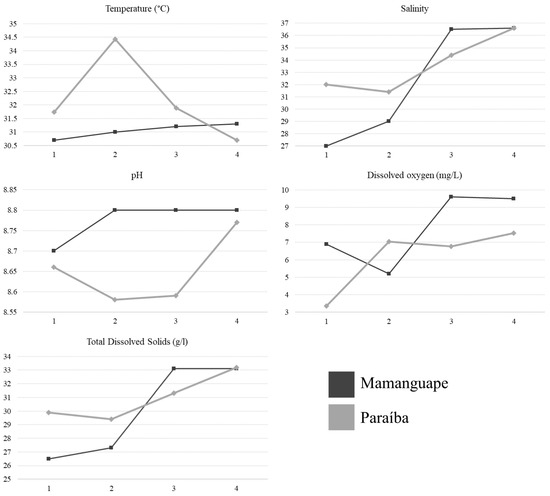
Figure 2.
Variation of environmental parameters, measured at the time of collection, in the different sectors of the Mamanguape River and Paraíba River estuaries in February 2020.
Both estuaries were dominated by sand fractions at all sampling points. In the Mamanguape estuary, sampling point 1 was dominated by coarse and medium sand fractions (36.6% and 18.64%, respectively; Figure 3A), while sampling point 2 was dominated by coarse and fine sand fractions (22.06% and 23.56%, respectively; Figure 3A). Sampling point 3 had mostly very coarse and coarse sand fractions (34.8% and 43.6%, respectively; Figure 3A). Sampling point 4 was dominated by medium and fine sand fractions (34.4% and 45.4%, respectively; Figure 3A). In the Paraíba estuary, no clear spatial pattern was observed; sampling point 1 was dominated by coarse and medium sand (52.53% combined), while fine sand dominated the intermediate sector (59.14%), coarse sand dominated sampling point 3 (50.8%; Figure 3B), and fine sand dominated sampling point 4 (39.34%; Figure 3B).
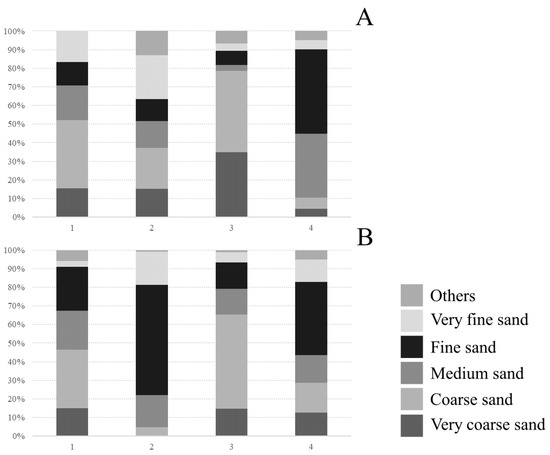
Figure 3.
Variation in the percentages of each granulometric fraction in the different sectors of the Mamanguape River (A) and Paraíba River (B) estuaries in February 2020. Others refer to the gravel, silt, and clay fractions combined.
Foraminifera densities ranged from 45.2 to 576.9 individuals/cm3, with averages (±SD) of 440.4 ± 220.7 ind/cm3 in the Mamanguape estuary and 221.7 ± 292.4 ind/cm3 in the Paraíba estuary (Figure 4). Density increased toward the outer parts of both estuaries, with averages in the outer sector of 558.6 ± 72.9 ind/cm3 in the Mamanguape estuary and 559.3 ± 547.7 ind/cm3 in the Paraíba estuary.
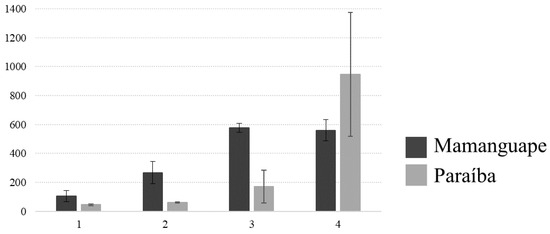
Figure 4.
Spatial variation of the mean density (ind/cm3 ± standard deviation) of benthic foraminifera in the Mamanguape and Paraíba river estuaries in February 2020. Error bars are the standard deviation.
A total of 60 foraminifera species were found, with 50 species in the Mamanguape estuary and 60 in the Paraíba estuary. Eight species were exclusive to the former, and 18 were exclusive to the latter (Table S1).
The number of species per sample ranged from 9 to 33.6, with averages of 10.4 ± 0.99 in the Mamanguape estuary and 25 ± 8.03 in the Paraíba estuary, showing a significant difference between the estuaries (ANOVA, p < 0.05; Table 1). In the Mamanguape estuary, species numbers increased toward the outer parts, the same trend was observed in the Paraíba estuary (Figure 5).

Table 1.
Summary of statistical results of two-way ANOVA examining the effect of different estuaries (Mamanguape or Paraíba River estuary) and sampling point on species number (S), diversity (H’) and evenness (J’).
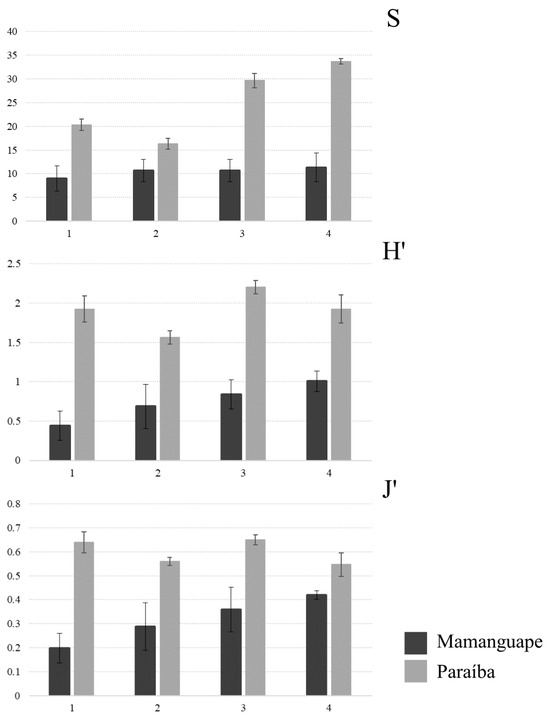
Figure 5.
Spatial variation in the mean number of species (S), Shannon–Wiener diversity (H’), and Pielou evenness (J’) of benthic foraminifera from the Mamanguape and Paraíba river estuaries in February 2020. Error bars represent standard deviation.
Diversity values ranged from 0.44 to 1.9, averaging 0.74 ± 0.23 in the Mamanguape estuary and 1. 90 ± 0.26 in the Paraíba estuary. The Mamanguape estuary showed an increasing trend in diversity towards the outer parts; in the Paraíba estuary this same trend could be observed (Figure 5).
Pielou’s evenness values ranged from 0.19 to 0.64, with means of 0.31 ± 0.09 in the Mamanguape estuary and 0.59 ± 0.05 in the Paraíba estuary. There was an increasing trend toward the outer parts of the Mamanguape estuary (Figure 5), while the Paraíba estuary showed little variation, with the highest average in sampling point 3 (0.64 ± 0.02).
Both estuaries were dominated by calcareous species, representing more than 70% of the total, followed by porcelaneous species (6–20%) and agglutinated species (0.2–2%). The most abundant species in both estuaries were Ammonia tepida, Ammonia parkinsoniana, Amphistegina gibbosa, Cribroelphidium excavatum, Haynesina germanica, Quinqueloculina milletti, and Quinqueloculina seminulum (Table S1; Figure 6).
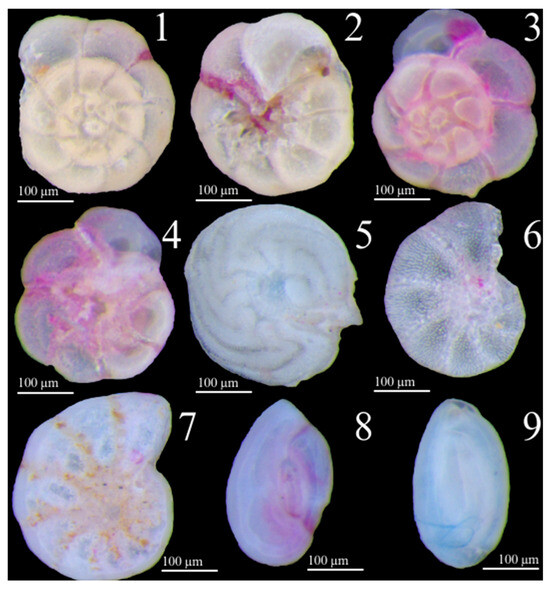
Figure 6.
Most abundant species of benthic foraminifera from the Mamanguape and Paraíba River estuaries. Ammonia parkinsoniana (1; spiral view), Ammonia parkinsoniana (2; umbilical view), Ammonia tepida (3; spiral view), Ammonia tepida (4; umbilical view), Amphistegina gibbosa (5), Elphidium excavatum (6), Haynesina germanica (7), Quinqueloculina milletti (8), and Quinqueloculina seminulum (9).
Community structure differed significantly between the factors tested and their interactions (PERMANOVA; p < 0.05; Table 2). Sampling points 3 and 4 of the Paraíba estuary were distinct from other sectors, with A. tepida accounting for a large portion of the population (37.07% and 57.05%, respectively), followed by A. parkinsoniana (23.75% and 0.20%, respectively) and A. gilatat (5.50% and 10.97%, respectively; Figure 7).

Table 2.
Results of PERMANOVA performed on the structure of the benthic foraminifera community of the Mamanguape and Paraíba river estuaries. DF = Degree of Freedom.
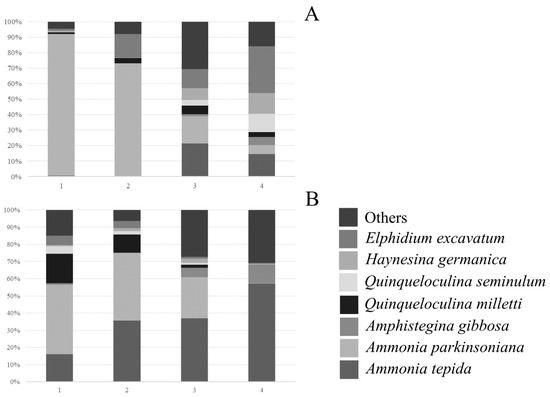
Figure 7.
Spatial variation in the abundance (%) of the main species of benthic foraminifera, by sector, of the Mamanguape River (A) and Paraíba River (B) estuaries in February 2020.
Species contributing to community differentiation included A. tepida, A. parkinsoniana, A. gibbosa, B. dilatata, B. striatula, C. excavatum, E. repandus, H. germanica, and Q. milletti (Table 3). Sampling point 1 showed 71.7% similarity, with A. parkinsoniana and A. tepida contributing most to this similarity (>40%; Table 3).

Table 3.
SIMPER results comparing the different sampling points (SP) of the estuary and the two estuaries of the present study. In parentheses are the average similarities (%) of each sector and the contribution (%) of the main species.
Axis 1 represented 47.9% of the total explained variance and was positively correlated with the factors very fine sand, coarse sand, very coarse sand, and others (Figure 8). Axis 2 represented 27.2% of the total explained variance and was positively correlated with very coarse sand, dissolved oxygen, salinity, total dissolved solids, pH, medium sand, very coarse sand, and others. A. parkinsoniana was positively correlated with very fine sand and negatively correlated with salinity and total dissolved solids.
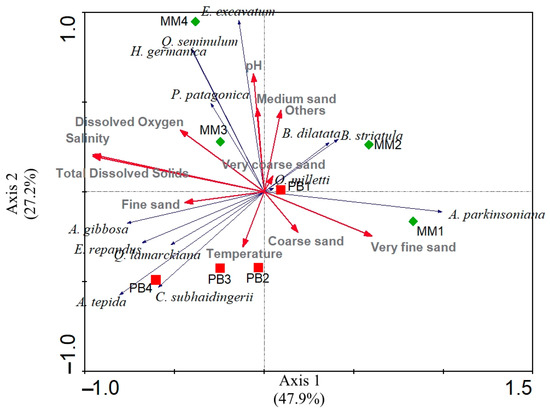
Figure 8.
RDA ordination diagrams of benthic foraminiferal fauna with environmental variables (temperature, salinity, dissolved solids, dissolved oxygen, pH, and grain size) from the Mamanguape and Paraíba river estuaries in February 2020.
4. Discussion
Both estuaries were dominated by calcareous species, followed by porcelaneous and agglutinated. Unlike the findings here, a clear transition from a biota dominated by calcareous taxa to one dominated by agglutinated taxa is common in many estuarine systems [73,74,75]. The dominance of calcareous species throughout the estuary in this study may be due to the absence of a pronounced gradient in salinity and pH as one moves toward the inner sector of both estuaries. Typically, calcareous foraminifera prefer areas closer to seawater, where higher salinities are observed [3,76]. In another study in a temperate region, calcareous species became dominant and expanded into the inner estuarine zones during summer when normal marine conditions prevailed [8]. In general, pH also influences the distribution of foraminifera, as calcareous forms are highly susceptible to dissolution under low pH, while agglutinated tests are more resistant and can dominate in acidic conditions [76,77]. In this study, pH remained constant in both estuaries, which, along with salinity, likely influenced the prevalence of calcareous species across sectors (see above).
The sediment grain size results from this study differed from other tropical and temperate estuaries [8,30,60,78]. In the Mamanguape River estuary, the inner and intermediate sectors were dominated by sand fractions, while the outer sector was dominated by medium and fine sand. No clear spatial pattern was observed in the Paraíba River estuary. The predominance of sandy grain sizes with coarse sediment fractions reveals a highly dynamic environment, unlike what is typically expected for tropical Brazilian estuaries, which are usually composed of fine sand associated with very fine sand and muddy sediments [30,64]. In another study of the Mamanguape River estuary, finer sediment fractions were dominant [79]. However, in a more recent study, coarse and medium sand fractions were found to be dominant [80], consistent with the present study. The observed characteristics suggest that these estuaries may be undergoing sediment distribution processes due to natural or anthropogenic dynamics, thereby altering the expected grain size pattern [81,82].
The number of species found in this study—50 in the Mamanguape River estuary and 60 in the Paraíba River estuary—was higher than that reported in most other tropical estuaries, ranging from 30 to 45 species [63,74,75,83], and temperate estuaries, ranging from 34 to 39 species [59,84]. In another study in the Mamanguape River estuary, 93 species were found [85], which is considerably higher than the present study, emphasizing the significant species richness of this estuary. Although the study was published in 2021, the samples were collected in 2006. There is also a difference in the sampling location. In the study by Sariaslan & Langer [85], the samples were collected in dense parts of mangroves. Therefore, the difference in the number of species may have been due to these two factors. It is worth noting that this estuary is located within an environmental protection area, possibly explaining the higher species count as evidence of its conservation status.
As previously presented, Shannon values increased as they approached the outermost part of the two estuaries. This trend is common in other estuarine environments [59,60,74]. Shannon diversity values in Paraíba estuary were similar to those observed in other tropical estuaries, ranging from 0 to 2.6 [63,83,86]. However, in the Mamanguape estuary, the values were lower than in other tropical estuaries (0.4–1), different from what was expected since this estuary is located in an environmental preservation area. The lowest Shannon diversity values in the Mamanguape estuary were observed at sampling points 1 and 2, where the species A. parkinsoniana was more abundant (91.5 and 72.6%, respectively). This species is known to be tolerant to low salinities [30,63,87], and it is believed that this is why it was more predominant in these two sampling points, perhaps for this reason it was more predominant in these 2 sampling points, which caused the diversity values to be lower. This also affects the values of Pielou’s evenness, which in the Mamanguape estuary were lower at sampling points 1 and 2 and, overall, were lower than in other tropical estuaries [63,83].
In the innermost sampling points of the present study, we noted the presence of species typical from both tropical [30,63,87] and temperate [88,89,90,91] transitional environments. The species were A. parkinsoniana, C. excavatum, and A. tepida, and they are considered resilient to salinity changes. The species found in the outermost part are typically associated with coarser sediment fractions and are adapted to high hydrodynamic environments [92,93,94]. These species were also noted in the outer sectors of other tropical estuaries [30,75,95].
The species structuring the Mamanguape River estuary community were A. parkinsoniana, C. excavatum, A. tepida, and H. germanica, which are typical estuarine species resilient to salinity changes. In the Paraíba River estuary, besides estuarine species, marine species adapted to high hydrodynamics, such as A. gibbosa, E. repandus, and Q. lamarckiana, also contributed to community structuring. The presence of these species indicates more efficient saline water renewal in the Paraíba River estuary compared to the Mamanguape River estuary, suggesting a higher potential for environmental recovery associated with geomorphological characteristics [33].
The genus Ammonia was dominant in both estuaries, thriving in natural and polluted environments. A. parkinsoniana was more abundant in the Mamanguape River estuary, suggesting less anthropogenic influence, this genus also was positively related with very fine sand and negatively related with salinity. While A. tepida dominated in the Paraíba River estuary, potentially indicating a higher degree of impact. Further studies are needed to assess the level of impact on the Paraíba River estuary.
5. Conclusions
This study found a higher abundance of calcareous foraminifera, followed by porcelaneous and agglutinated species, primarily due to the consistent salinity and pH levels in both estuaries. Grain size, mostly sandy, also influenced the predominance of calcareous species.
Estuarine species contributed to structuring communities in the inner and intermediate sectors, while marine species did so in the outer sector. The structuring species in the Mamanguape River estuary were typical of estuarine environments, while marine species were also found in the Paraíba River estuary, indicating a higher capacity for marine water renewal.
Supplementary Materials
The following supporting information can be downloaded at: https://www.mdpi.com/article/10.3390/d17030142/s1, Table S1: Relative abundance (%) of species from the Mamanguape and Paraíba river estuaries. Where (A) are agglutinating foraminifera, (C) are calcareous foraminifera and (P) are porcelain foraminifera.
Author Contributions
Investigation, B.M.A.; Conceptualization, Formal analysis, Writing—review & editing, B.M.A., P.B.E.-B. and M.N.J. All authors have read and agreed to the published version of the manuscript.
Funding
This research was funded by National Council for Scientific and Technological Development (CNPq) grant number 130153/2020-6 to Bruna Marinho Alves, the Coordination for the Improvement of Higher Education Personnel (Capes) grant number 88887.713780/2022-00 to Bruna Marinho Alves. The Coordination for the Improvement of Higher Education Personnel (Capes) grant number 98/2017-05, PVE 151-2012, AuxPe 242-2013, 23038.004320/2014-1 to Patricia Beck Eichler-Barker and the Ocean Sciences Department of the University of California at Santa Cruz (UCSC) and at the Moss Landing Marine Laboratories of San Jose State University (MLML/SJSU) grant number 88887.305531/2018-00, 88881.188496/2018-01 and 9999.000098/2017-05 to Patricia Beck Eichler-Barker.
Institutional Review Board Statement
Not applicable.
Data Availability Statement
All data is provided.
Acknowledgments
We would like to thank the National Council for Scientific and Technological Development (CNPq) for the master’s scholarship (130153/2020-6) granted to the first author, which allowed the execution of this study. We would also like to thank the Coordination for the Improvement of Higher Education Personnel (Capes) for the doctoral scholarship (88887.713780/2022-00) granted to the first author of the article, which allows us to keep up our studies on the benthic foraminifera of Paraíba. We are very grateful to the Marine Geology and Geophysical and Environmental Monitoring Laboratories (Laboratório de Geologia e Geofísica Marinha e Monitoramento Ambiental/GGEMMA) and to the Graduate Program in Geology and Geodynamics (PPGG) of the Federal University of Rio Grande do Norte (UFRN). We are deeply grateful to CAPES through Special Visiting Professor project (98/2017-05, PVE 151-2012, AuxPe 242-2013) and Ciências do Mar II (23038.004320/2014-1), who allowed a Post Doc fellowship for the second author at the Ocean Sciences Department of the University of California at Santa Cruz (UCSC) and at the Moss Landing Marine Laboratories of San Jose State University (MLML/SJSU) (88887.305531/2018- 00, 88881.188496/2018-01 and 9999.000098/2017-05). We also thank Luke C. Strotz who was one of the reviewers of the paper and brought up important issues for improving our study.
Conflicts of Interest
The authors declare no conflict of interest.
References
- Boltovskoy, E.; Giussani, G.; Watanabe, S.; Wright, R. Atlas of Benthic Shelf Foraminifera of the Southwest Atlantic; Springer: Dordrecht, The Netherlands, 1980. [Google Scholar]
- Sen Gupta, B.K. Modern Foraminifera; Kluwer Academic Publishers: New York, NY, USA; Boston, MA, USA; Dordrecht, The Netherlands; London, UK; Moscow, Russia, 2003. [Google Scholar]
- Murray, J.W. Ecology and Applications of Benthic Foraminifera; Cambridge University Press: Cambridge, UK, 2006. [Google Scholar]
- Siemensma, F.; Apothéloz-Perret-Gentil, L.; Holzmann, M.; Clauss, S.; Völcker, E.; Pawlowski, J. Taxonomic revision of freshwater foraminifera with the description of two new agglutinated species and genera. Eur. J. Protistol. 2017, 60, 28–44. [Google Scholar] [CrossRef] [PubMed]
- Hayward, B.W.; Cedhagen, T.; Kaminski, M.; Gross, O. World Foraminifera Database. 2018. Available online: http://www.marinespecies.org/foraminifera (accessed on 18 October 2021).
- Kramer, K.J.M.; Botterweg, J. Bioindicators and Environmental Management; Jefrey, D.W., Madden, B., Eds.; Academic Press: London, UK, 1991; pp. 95–126. [Google Scholar]
- Schönfeld, J.; Alve, E.; Geslin, E.; Jorissen, F.; Korsun, S.; Spezzaferri, S.; Members of the FOBIMO Group. The FOBIMO (FOraminiferal BIo-MOnitoring) initiative—Towards a standardised protocol for soft-bottom benthic foraminiferal monitoring studies. Mar. Micropaleontol. 2012, 94, 1–13. [Google Scholar] [CrossRef]
- Francescangeli, F.; Milker, Y.; Bunzel, D.; Thomas, H.; Norbisrath, M.; Schönfeld, J.; Schmiedl, G. Recent benthic foraminiferal distribution in the Elbe Estuary (North Sea, Germany): A response to environmental stressors. Estuar. Coast. Shelf Sci. 2021, 251, 107198. [Google Scholar] [CrossRef]
- Hallock, P. Production of carbonate sediments by selected large benthic foraminifera on two Pacific coral reefs. J. Sediment. Res. 1981, 51, 467–474. [Google Scholar] [CrossRef]
- Langer, M.R.; Silk, M.T.; Lipps, J.H. Global ocean carbonate and carbon dioxide production; the role of reef Foraminifera. J. Foraminifer. Res. 1997, 27, 271–277. [Google Scholar] [CrossRef]
- Groß, O. Sediment interactions of foraminifera: Implications for food degradation and bioturbation processes. J. Foraminifer. Res. 2002, 32, 414–424. [Google Scholar] [CrossRef]
- Langer, M.R. Assessing the contribution of foraminiferan protists to global ocean carbonate production 1. J. Eukaryot. Microbiol. 2008, 55, 163–169. [Google Scholar] [CrossRef] [PubMed]
- Piña-Ochoa, E.; Høgslund, S.; Geslin, E.; Cedhagen, T.; Revsbech, N.P.; Nielsen, L.P.; Schweizer, M.; Jorissen, F.; Rysgaard, S.; Risgaard-Petersen, N. Widespread occurrence of nitrate storage and denitrification among Foraminifera and Gromiida. Proc. Natl. Acad. Sci. USA 2010, 107, 1148–1153. [Google Scholar] [CrossRef] [PubMed]
- Cesbron, F.; Geslin, E.; Jorissen, F.J.; Delgard, M.L.; Charrieau, L.; Deflandre, B.; Jézéquel, D.; Anschutz, P.; Metzger, E. Vertical distribution and respiration rates of benthic foraminifera: Contribution to aerobic remineralization in intertidal mudflats covered by Zostera noltei meadows. Estuar. Coast. Shelf Sci. 2016, 179, 23–38. [Google Scholar] [CrossRef]
- Enge, A.J.; Wukovits, J.; Wanek, W.; Watzka, M.; Witte, U.F.; Hunter, W.R.; Heinz, P. Carbon and nitrogen uptake of calcareous benthic foraminifera along a depth-related oxygen gradient in the OMZ of the Arabian Sea. Front. Microbiol. 2016, 7, 71. [Google Scholar] [CrossRef] [PubMed]
- Wukovits, J.; Oberrauch, M.; Enge, A.J.; Heinz, P. The distinct roles of two intertidal foraminiferal species in phytodetrital carbon and nitrogen fluxes–results from laboratory feeding experiments. Biogeosciences 2018, 15, 6185–6198. [Google Scholar] [CrossRef]
- Li, T.; Zhang, M.; Li, B.; Cai, G.; Li, S.; Nie, X. Co-occurrence patterns and community assembly mechanisms of benthic foraminiferal communities in South Chinese bays. Ecol. Indic. 2022, 144, 109489. [Google Scholar] [CrossRef]
- Jorissen, F.J.; De Stigter, H.C.; Widmark, J.G.V. A conceptual model explaining benthic foraminiferal microhabitats. Mar. Micropaleontol. 1995, 26, 3–15. [Google Scholar] [CrossRef]
- Schmiedl, G.; Mackensen, A.; Müller, P.J. Recent benthic foraminifera from the eastern South Atlantic Ocean: Dependence on food supply and water masses. Mar. Micropaleontol. 1997, 32, 249–287. [Google Scholar] [CrossRef]
- Fontanier, C.; Jorissen, F.J.; Chaillou, G.; David, C.; Anschutz, P.; Lafon, V. Seasonal and internnual variability of benthic foraminiferal faunas at 550 m depth in the Bay of Biscay. Deep-Sea Res. I 2003, 50, 457–494. [Google Scholar] [CrossRef]
- Hess, S.; Jorissen, F.J. Distribution patterns of living benthic foraminifera from Cap Breton Canyon, Bay of Biscay: Faunal response to sediment instability. Deep-Sea Res. I 2009, 56, 1555–1578. [Google Scholar] [CrossRef]
- Magno, M.C.; Bergamin, L.; Finoia, M.G.; Pierfranceschi, G.; Venti, F.; Romano, E. Correlation between textural characteristics of marine sediments and benthic foraminifera in highly anthropogenically-altered coastal areas. Mar. Geol. 2012, 315, 143–161. [Google Scholar] [CrossRef]
- Murray, J.W. Ecology and Palaeoecology of Benthic Foraminifera; Logman Scientific & Technical: London, UK, 1991. [Google Scholar]
- Scott, D.B.; Medioli, F.S.; Schafer, C.T. Monitoring in Coastal Environments Using Foraminifera and Thecamoebian Indicators; Cambridge University Press: Cambridge, UK, 2002. [Google Scholar]
- Hallock, P.; Lidz, B.H.; Cockey-Burkhard, E.M.; Donnelly, K.B. Foraminifera as bioindicators in coral reef assessment and monitoring: The FORAM index. Environ. Monit. Assess. 2003, 81, 221–238. [Google Scholar] [CrossRef] [PubMed]
- Prazeres, M.; Martínez-Colón, M.; Hallock, P. Foraminifera as bioindicators of water quality: The FoRAM Index revisited. Environ. Pollut. 2020, 257, 113612. [Google Scholar] [CrossRef] [PubMed]
- Kaiho, K. Benthic foraminiferal dissolved-oxygen index and dissolved-oxygen levels in the modern ocean. Geology 1994, 22, 719–722. [Google Scholar] [CrossRef]
- Le Cadre, V.; Debenay, J.P. Morphological and cytological responses of ammonia (foraminifera) to copper contamination: Implication for the use of foraminifera as bioindicators of pollution. Environ. Pollut. 2006, 143, 304–317. [Google Scholar] [CrossRef]
- Nikulina, A.; Polovodova, I.; Schönfeld, J. Environmental response of living benthic foraminifera in Kiel Fjord, SW Baltic Sea. eEarth 2008, 3, 37–49. [Google Scholar] [CrossRef]
- Laut, L.; Da Matta, G.; Camara, G.; Belart, P.; Clemente, I.; Ballalai, J.; Volino, E.; Couto, E.D.C.G. Living and dead foraminifera assemblages as environmental indicators in the Almada River Estuary, Ilheus, northeastern Brazil. J. S. Am. Earth Sci. 2021, 105, 102883. [Google Scholar] [CrossRef]
- Lauchlan, S.S.; Nagelkerken, I. Species range shifts along multistressor mosaics in estuarine environments under future climate. Fish Fish. 2020, 21, 32–46. [Google Scholar] [CrossRef]
- Colombano, D.D.; Litvin, S.Y.; Ziegler, S.L.; Alford, S.B.; Baker, R.; Barbeau, M.A.; Cebrián, J.; Connolly, R.M.; Currin, C.A.; Deegan, L.A.; et al. Climate change implications for tidal marshes and food web linkages to estuarine and coastal nekton. Estuaries Coasts 2021, 44, 1–12. [Google Scholar] [CrossRef]
- Eichler, P.P.; Barker, C.P.; De Miranda, L.B. Benthic foraminifera as indicators of water renewal in Bertioga estuarine channel (SP, Brazil). Environ. Monit. Assess. 2021, 193, 1–23. [Google Scholar] [CrossRef] [PubMed]
- Flemer, D.A.; Champ, M.A. What is the future fate of estuaries given nutrient over-enrichment, freshwater diversion and low flows? Mar. Pollut. Bull. 2006, 52, 247–258. [Google Scholar] [CrossRef] [PubMed]
- Burone, L.; Venturini, N.; Sprechmann, P.; Valente, P.; Muniz, P. Foraminiferal responses to polluted sediments in the Montevideo coastal zone, Uruguay. Mar. Pollut. Bull. 2006, 52, 61–73. [Google Scholar] [CrossRef]
- Sousa, S.H.D.M.; Yamashita, C.; Semensatto, D.L.; Santarosa, A.C.A.; Iwai, F.S.; Omachi, C.Y.; Disaró, S.T.; Martins, M.V.A.; Barbosa, C.F.; Bonetti, C.H.C.; et al. Opportunities and challenges in incorporating benthic foraminifera in marine and coastal environmental biomonitoring of soft sediments: From science to regulation and practice. J. Sediment. Environ. 2020, 5, 257–265. [Google Scholar] [CrossRef]
- Włodarska-Kowalczuk, M.; Pawłowska, J.; Zajączkowski, M. Do foraminifera mirror diversity and distribution patterns of macrobenthic fauna in an Arctic glacial fjord? Mar. Micropaleontol. 2013, 103, 30–39. [Google Scholar] [CrossRef]
- Debenay, J.P.; Bicchi, E.; Goubert, E.; Armynot Du Châtelet, E. Spatio-temporal distribution of benthic foraminifera in relation to estuarine dynamics (Vie estuary, Vendée, W France). Estuar. Coast. Shelf Sci. 2006, 67, 181–197. [Google Scholar] [CrossRef]
- Gupta, B.K.S.; Platon, E. Tracking Past Sedimentary Records of Oxygen Depletion in Coastal Waters. J. Coast. Res. 2006, III, 1351–1355. Available online: https://www.jstor.org/stable/25742974 (accessed on 27 November 2024).
- Frontalini, F.; Buosi, C.; Da Pelo, S.; Coccioni, R.; Cherchi, A.; Bucci, C. Benthic foraminifera as bio-indicators of trace element pollution in the heavily contaminated Santa Gilla lagoon (Cagliari, Italy). Mar. Pollut. Bull. 2009, 58, 858–877. [Google Scholar] [CrossRef]
- Moksness, E.; Dahl, E.; Støttrup, J. Integrated Coastal Zone Management, Integrated Coastal Zone Management; Wiley-Blackwell: Hoboken, NJ, USA, 2009. [Google Scholar] [CrossRef]
- Antonarakou, A.; Kontakiotis, G.; Zarkogiannis, S.; Mortyn, P.G.; Drinia, H.; Koskeridou, E.; Anastasakis, G. Planktonic foraminiferal abnormalities in coastal and open marine eastern Mediterranean environments: A natural stress monitoring approach in recent and early Holocene marine systems. J. Mar. Syst. 2018, 181, 63–78. [Google Scholar] [CrossRef]
- Bergamin, L.; Pierfranceschi, G.; Romano, E. Anthropogenic impact due to mining from a sedimentary record of a marine coastal zone (SW Sardinia, Italy). Mar. Micropaleontol. 2021, 169, 102036. [Google Scholar] [CrossRef]
- Spalding, M.D.; Fox, H.E.; Allen, G.R.; Davidson, N.; Ferdaña, Z.A.; Finlayson, M.; Halpern, B.S.; Jorge, M.A.; Lombana, A.; Lourie, S.A.; et al. Marine ecoregions of the world: A bioregionalization of coastal and shelf areas. BioScience 2007, 57, 573–583. [Google Scholar] [CrossRef]
- Alvares, C.A.; Stape, J.L.; Sentelhas, P.C.; Gonçalves, J.D.M.; Sparovek, G. Köppen’s climate classification map for Brazil. Meteorol. Z. 2013, 22, 711–728. [Google Scholar] [CrossRef] [PubMed]
- Alves, V.E.N.; Patrício, J.; Dolbeth, M.; Pessanha, A.; Palma, A.R.T.; Dantas, E.W.; Vendel, A.L. Do different degrees of human activity affect the diet of Brazilian silverside Atherinella brasiliensis? J. Fish Biol. 2016, 89, 1239–1257. [Google Scholar] [CrossRef]
- CPTEC/INPE. Proclima: Programa de Monitoramento Climático em Tempo Real da Região Nordeste—Análise Municipal das Componentes do Balanço Hídrico. Available online: http://proclima.cptec.inpe.br/ (accessed on 1 November 2015).
- Nishida, A.K.; Nordi, N.; Alves, R.R.N. Abordagem Etnoecológica Da Coleta De Moluscos No Litoral Paraibano. Trop. Oceanogr. 2004, 32, 53–68. [Google Scholar] [CrossRef]
- AESA. Agência Executiva de Gestão das Aguás do Estado da Paraíba. Available online: http://www.aesa.pb.gov.br/aesa-website/ (accessed on 17 October 2020).
- AESA. Relação dos Açudes Monitorados. Available online: https://site2.aesa.pb.gov.br/aesa/volumesAcudes.do?metodo=listarAcudesUltimaCota/ (accessed on 1 November 2015).
- BRASIL, Ministério do Meio Ambiente/Secretaria de Biodiversidade e Florestas. Áreas Prioritárias para Conservação, Uso Sustentável e Repartição de Benefícios da Biodiversidade Brasileira: Atualização—Portaria MMA n°9, de 23 de Janeiro de 2007; MMA: Brasília, Brazil, 2007. [Google Scholar]
- Sassi, R.; Watanabe, T. Estudos ecológicos básicos no estuário do Rio Paraíba do Norte, Paraíba, Brasil. Fitoplâncton e fatores hidrológicos. Simpósio Nac. Ecol. 1980, 2, 305–313. [Google Scholar]
- Marcelino, R.L.; Sassi, R.; Cordeiro, T.A.; Costa, C.F. Uma abordagem sócio-econômica e sócio-ambiental dos pescadores artesanais e outros usuários ribeirinhos do Estuário do Rio Paraíba do Norte, estado da Paraíba. Trop. Oceanogr. 2005, 33, 183–197. [Google Scholar] [CrossRef]
- Oliveira, I.S. Uso do Conhecimento Tradicional dos Catadores de Caranguejo-Uçá Ucides cordatus, (LINNAEUS, 1763) para a Identificação dos Principais Locais de Catação, no Estuário do Rio Mamanguape-PB. Master’s Thesis, Universidade Federal da Paraíba, João Pessoa, Brazil, 2009. [Google Scholar]
- Rocha, M.S.P.; Mourão, J.S.; Souto, W.M.S.; Barboza, R.R.D.; Alves, R.R.N. Use of fishing resources in the Mamanguape river estuary, Paraiba state, Brazil. Interciencia 2008, 33, 903–909. [Google Scholar] [CrossRef]
- Schlitzer, R. Ocean Data View. 2021. Available online: http://odv.awi.de (accessed on 31 May 2022).
- UNESCO. Background papers and supporting data on the Practical Salinity Scale 1978. UNESCO Tech. Pap. Mar. Sci. 1981, 37, 1–145. [Google Scholar]
- Boltovskoy, E.; Giussani, G.; Watanabe, S.; Wright, R.C. Atlas of Benthic Shelf foraminifera of the Southwest Atlantic; Springer Science & Business Media: Berlin/Heidelberg, Germany, 2012. [Google Scholar]
- Laut, L.L.M.; De Almeida Cabral, I.; Da Conceição Rodrigues, M.A.; Silva, F.S.; Martins, M.V.A.; Boski, T.; Gomes, A.; Dias, J.M.A.; Fontana, L.F.; Laut, V.M.; et al. Compartimentos ambientais do Estuário do Rio Arade, Sul de Portugal, com base na distribuição e ecologia de foraminíferos. Anu. Inst. Geociênc. 2014, 37, 60–74. [Google Scholar] [CrossRef]
- Laut, L.L.M.; Clemente, I.M.M.M.; Belart, P.; Martins, M.V.A.; Frontalini, F.; Laut, V.M.; Gomes, A.; Boski, T.; Lorini, M.L.; Fortes, R.R.; et al. Multiproxies (benthic foraminifera, ostracods and biopolymers) approach applied to identify the environmental partitioning of the Guadiana River Estuary (Iberian Peninsula). J. Sediment. Environ. 2016, 1, 178–195. [Google Scholar] [CrossRef]
- Lei, Y.; Li, T. Atlas of Benthic Foraminifera from China Seas; Springer: Berlin/Heidelberg, Germany, 2016; pp. 89–134. [Google Scholar]
- Symphonia, T.K.; Senthil, N.D. Taxonomic notes on Recent Foraminifera from the Continental Shelf-Slope Region of Southwestern Bay of Bengal, East Coast of India. Palaeont. Electr. 2019, 22, 1–89. [Google Scholar] [CrossRef] [PubMed]
- Damasio, B.V.; Timoszczuk, C.T.; Kim, B.S.M.; E Sousa, S.H.D.M.; Bícego, M.C.; Siegle, E.; Figueira, R.C.L. Impacts of hydrodynamics and pollutants on foraminiferal fauna distribution in the Santos Estuary (SE Brazil). J. Sediment. Environ. 2020, 5, 61–86. [Google Scholar] [CrossRef]
- Suguio, K. Introdução à Sedimentologia; Edgard Bliicher: São Paulo, Brazil, 1973. [Google Scholar]
- Shannon, C.E.; Weaver, W. The Mathematical Theory of Communication; The University of Illinois Press: Urbana, IL, USA, 1949. [Google Scholar]
- Pielou, E.C. Ecological Diversity; John Wiley & Sons: New York, NY, USA, 1975. [Google Scholar]
- Anderson, M.I. A new method for non-parametric multivariate analysis of variance. Austral Ecol. 2001, 26, 32–46. [Google Scholar] [CrossRef]
- Clarke, K.R.; Warwick, R.M. Change in marine communities. Approach Stat. Anal. Interpret. 2001, 2, 1–168. [Google Scholar]
- Leps, J.; Šmilauer, P. Multivariate Analysis of Ecological Data Using CANOCO; Cambridge University Press: Cambridge, UK, 2003. [Google Scholar]
- Clarke, K.; Gorley, R. PRIMER V6. User Manual/Tutorial; Plymouth Mariner Laboratory: Plymouth, UK, 2006. [Google Scholar]
- Anderson, M.J.; Gorley, R.N.; Clarke, K.R. PERMANOVA for PRIMER: Guide to Software and Statistical Methods; PRIMER-E Ltd.: Plymouth, UK, 2008. [Google Scholar]
- Statsoft. Statistica (Data Analysis Software System) Version 8.0; StatSoft, Inc. CD-ROM: Tulsa, OK, USA, 2007. [Google Scholar]
- Eichler, P.P.B.; Eichler, B.B.; Miranda, L.B.; Rodrigues, A.R. Modern foraminiferal facies in a subtropical estuarine channel, Bertioga, São Paulo, Brazil. J. Foramin. Res. 2007, 37, 234–247. [Google Scholar] [CrossRef]
- Souza, V.M.; Laut, L.M.; Da Silva, F.S.; De Figueiredo Jr, A.G.; Vital, H.; Frazão, E. Benthic foraminifera and bacterial activity as a proxy for environmental characterization in Potengi Estuary, Rio Grande do Norte, Brazil. Anu. Inst. Geociênc. 2010, 33, 20–34. [Google Scholar] [CrossRef]
- Farias, C.L.C.; Beck Eichler, P.P.; Vital, H.; Praxedes Gomes, M. Influência de Variações Ambientais e da Dinâmica Sedimentar na Distribuição de Foraminíferos no Estuário do Rio Potengi (RN, Brasil). Anu. Inst. Geociênc. 2019, 42, 112–128. [Google Scholar] [CrossRef]
- Lal, K.K.; Bonetti, C.; Woodroffe, C.D.; Rogers, K. Contemporary distribution of benthic foraminiferal assemblages in coastal wetlands of south-eastern Australia. Estuar. Coast. Shelf Sci. 2020, 245, 106949. [Google Scholar] [CrossRef]
- Dias, B.B.; Hart, M.B.; Smart, C.W.; Hall-Spencer, J.M. Modern seawater acidification: The response of foraminifera to high-CO2 conditions in the Mediterranean Sea. J. Geol. Soc. 2010, 167, 843–846. [Google Scholar] [CrossRef]
- Rodrigues, A.R.; Eichler, P.B.; Eichler, B.B. Utilização de foraminíferos no monitoramento do Canal de Bertioga (SP, BRASIL). Revista Atlântica 2003, 25, 35–51. [Google Scholar]
- Silva, S.T.Â.D. Diversidade e Estrutura da Nematofauna em Regiões Estuarinas Tropicais (~7° S). Master’s Thesis, Universidade Federal da Paraíba, João Pessoa, Brazil, 2017. [Google Scholar]
- Pereira, E.D.A.A.; De Paiva, W.; Molozzi, J.; Lopes, W.S. Sediment and tissue analysis for metals in a tropical estuary. Reg. Stud. Mar. Sci. 2020, 38, 101358. [Google Scholar] [CrossRef]
- Veronez Júnior, P.; Bastos, A.C.; Quaresma, V.D.S. Morfologia e distribuição sedimentar em um sistema estuarino tropical: Baía de Vitória, ES. Braz. J. Geophys. 2009, 27, 609–624. [Google Scholar] [CrossRef]
- Barcellos, R.L.; Figueira, R.C.L.; França, E.J.; Schettini, C.A.; De Arruda Xavier, D. Changes of estuarine sedimentation patterns by urban expansion: The case of Middle Capibaribe Estuary, Northeastern Brazil. Int. J. Geosci. 2017, 8, 514–535. [Google Scholar] [CrossRef][Green Version]
- Nagendra, R.; Reddy, A.N. Benthic foraminifera response to ecosystem pollution in the Uppanar Estuary, Tamil Nadu Coast, India. J. Geol. Soc. India 2019, 93, 555–566. [Google Scholar] [CrossRef]
- Guerra, L.; Veiga-Pires, C.; González-Regalado, M.L.; Abad, M.; Toscano, A.; Muñoz, J.M.; Ruiz, F.; Vidal, J.R.; Cáceres, L.M.; Izquierdo, T.; et al. Relationship between substrate, physico-chemical parameters and foraminiferal tests in the Doñana National Park, a Biosphere Reserve in SW Spain. J. Iber. Geol. 2020, 46, 21–38. [Google Scholar] [CrossRef]
- Sariaslan, N.; Langer, M.R. Atypical, high-diversity assemblages of foraminifera in a mangrove estuary from Northern Brazil. Biogeosciences Discuss. 2021, 18, 1–29. [Google Scholar] [CrossRef]
- Pregnolato, L.A.; De Almeida Viana, R.; Passos, C.C.; Misailidis, M.L.; Duleba, W. Ammonia-Elphidium index as a proxy for marine pollution assessment, Northeast Brazil. J. Sediment. Environ. 2018, 3, 176–186. [Google Scholar] [CrossRef]
- Belart, P.; Laut, V.M.; Fortes, R.; Clemente, I.M.M.M.; Raposo, D.S.; Martins, V.; Frontalini, F.; Lorini, M.L.; Fortes, R.R.; Laut, L. Living benthic Foraminifera from the Saquarema lagoonal system (Rio de Janeiro, southeastern Brazil). Check List 2017, 13, 1. [Google Scholar] [CrossRef][Green Version]
- Laut, L.; Clemente, I.; Martins, M.V.A.; Frontalini, F.; Raposo, D.; Belart, P.; Habib, R.; Fortes, R.; Lorini, M.L. Benthic Foraminifera and Thecamoebians of Godineau River Estuary, Gulf of Paria, Trinidad Island. Anu. Inst. Geociênc. 2017, 40, 118–143. [Google Scholar]
- Barbieri, G.; Vaiani, S.C. Benthic foraminifera or Ostracoda? Comparing the accuracy of palaeoenvironmental indicators from a Pleistocene lagoon of the Romagna coastal plain (Italy). J. Micropala 2018, 37, 203–230. [Google Scholar] [CrossRef]
- Haller, C.; Smith, C.G.; Hallock, P.; Hine, A.C.; Osterman, L.E.; McCloskey, T. Distribution of modern salt-marsh foraminifera from the eastern Mississippi Sound, USA. J. Foramin. Res. 2019, 49, 29–47. [Google Scholar] [CrossRef]
- Ruiz, F.; González-Regalado, M.L.; Pendón, J.G.; Abad, M.; Olías, M.; Muñoz, J.M. Correlation between foraminifera and sedimentary environments in recent estuaries of southwestern Spain: Applications to Holocene reconstructions. Quatern. Int. 2005, 140, 21–36. [Google Scholar] [CrossRef]
- Edwards, P.G. Aspects of Micropalaeontology; Springer: Dordrecht, The Netherlands, 1982; pp. 111–141. [Google Scholar]
- Alves, B.M.; Nogueira Junior, M. Foraminiferal assemblage structure from Brazilian tropical urbanized beaches (~7° S). An. Acad. Bras. Ciênc. 2020, 92, 1–15. [Google Scholar] [CrossRef]
- Buragohain, D.; Ghosh, A. Seasonal Distribution Trends of Benthic Foraminiferal Assemblages from the Saurashtra Coast, Western India. J. Geol. Soc. India 2021, 97, 61–69. [Google Scholar] [CrossRef]
- Nagendra, R.; Sathiyamoorthy, P.; Reddy, A.N.; Ramachandran, A. Spatial distribution of benthic foraminifera in the Palar estuary, Tamil Nadu. J. Geol. Soc. India 2015, 86, 305–316. [Google Scholar] [CrossRef]
Disclaimer/Publisher’s Note: The statements, opinions and data contained in all publications are solely those of the individual author(s) and contributor(s) and not of MDPI and/or the editor(s). MDPI and/or the editor(s) disclaim responsibility for any injury to people or property resulting from any ideas, methods, instructions or products referred to in the content. |
© 2025 by the authors. Licensee MDPI, Basel, Switzerland. This article is an open access article distributed under the terms and conditions of the Creative Commons Attribution (CC BY) license (https://creativecommons.org/licenses/by/4.0/).